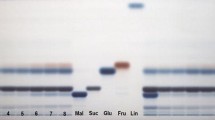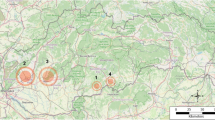Abstract
Sugar profiles of different almond and chestnut cultivars were obtained by high-performance liquid chromatography (HPLC), by means of a refractive index (RI) detector. A solid-liquid extraction procedure was used in defatted and dried samples. The chromatographic separation was achieved using a Eurospher 100-5 NH2 column using an isocratic elution with acetonitrile/water (70:30, v/v) at a flow rate of 1.0 ml/min. All the compounds were separated in 16 min. The method was optimized and proved to be reproducible and accurate. Generally, more than 95% of sugars were identified for both matrixes. Sugars profiles were quite homogeneous for almond cultivars; sucrose was the main sugar (11.46 ± 0.14 in Marcona to 22.23 ± 0.59 in Ferragnes g/100 g of dried weight), followed by raffinose (0.71 ± 0.05 in Ferraduel to 2.11 ± 0.29 in Duro Italiano), glucose (0.42 ± 0.12 in Pegarinhos two seeded to 1.47 ± 0.19 in Ferragnes) and fructose (0.11 ± 0.02 in Pegarinhos two seeded to 0.59 ± 0.05 in Gloriette). Commercial cultivars proved to have higher sucrose contents, except in the case of Marcona. Nevertheless, chestnut cultivars revealed a high heterogeneity. Sucrose was the main sugar in Aveleira (22.05 ± 1.48), Judia (23.30 ± 0.83) and Longal (9.56 ± 0.91), while glucose was slightly prevalent in Boa Ventura (6.63 ± 0.49). The observed variance could serve for inter-cultivar discrimination.


Similar content being viewed by others
Abbreviations
- FAO:
-
Food and Agriculture Organization
- HPLC:
-
High-performance liquid chromatography
- IS:
-
Internal standard
- PDO:
-
Protected designation of origin
- RI:
-
Refractive index
References
Barreira JCM, Ferreira ICFR, Oliveira MBPP, Pereira JA (2008) Antioxidant activity and bioactive compounds of ten Portuguese regional and commercial almond cultivars. Food Chem Toxicol 46:2230–2235
Balta F, Battal P, Balta MF, Yoruk HI (2009) Free sugar compositions based on kernel taste in almond genotypes Prunus dulcis from Eastern Turkey. Chem Nat Compd 45:221–224
Cordeiro V, Monteiro A (2001) Almond growing in Trás-os-Montes region (Portugal). Acta Hort 591:161–165
Ahrens S, Venkatachalam M, Mistry AM, Lapsley K, Sathe SK (2005) Almond (Prunus dulcis L.) protein quality. Plant Food Hum Nutr 60:123–128
Barreira JCM, Casal S, Ferreira ICFR, Oliveira MBPP, Pereira JA (2009) Nutritional, fatty acid and triacylglycerol profiles of Castanea sativa Mill. cultivars: a compositional and chemometric approach. J Agric Food Chem 57:2836–2842
Borges O, Gonçalves B, Carvalho JLS, Correia P, Silva AP (2008) Nutritional quality of chestnut (Castanea sativa Mill.) cultivars from Portugal. Food Chem 106:976–984
Kazantzis I, Nanos GD, Stavroulakis GG (2003) Effect of harvest time and storage conditions on almond kernel oil and sugar composition. J Sci Food Agric 83:354–359
Barreira JCM, Alves RC, Casal S, Ferreira ICFR, Oliveira MBPP, Pereira JA (2009) Vitamin E profile as a reliable authenticity discrimination factor between Chestnut (Castanea sativa Mill.) cultivars. J Agric Food Chem 57:5524–5528
Barreira JCM, Ferreira ICFR, Oliveira MBPP, Pereira JA (2008) Antioxidant activities of the extracts from chestnut flower, leaf, skins and fruit. Food Chem 107:1106–1113
Künsch U, Schärer H, Patrian B, Höhn E, Conedera M, Sassella A, Jermini M, Jelmini G (2001) Effects of roasting on chemical composition and quality of different chestnut (Castanea sativa Mill.) varieties. J Sci Food Agric 81:1106–1112
Bernárdez MM, Miguélez JM, Queijeiro JG (2004) HPLC determination of sugars in varieties of chestnut fruits from Galicia (Spain). J Food Comp Anal 17:63–67
Nanos GD, Kazantzis I, Kefalas P, Petrakis C, Stavroulakis GG (2002) Irrigation and harvest time affect almond kernel quality and composition. Sci Hortic 96:249–256
Saura-Calixto F, Canellas J, Raso-Garcia A (1984) Gas chromatographic analysis of sugars and sugar-alcohols in the mesocarp, endocarp and kernel of almond fruit. J Agric Food Chem 32:1018–1020
Soler L, Canellas J, Saura-Calixto F (1989) Changes in carbohydrate and protein content and composition of developing almond seeds. J Agric Food Chem 37:1400–1404
Bliss FA (1999) Nutritional improvement of horticultural crops through plant breeding. Hortscience 34:1163–1167
Acknowledgements
Foundation for Science and Technology (Portugal) for financial support to J.C.M. Barreira (SFRH/BD/29060/2006) and INTERREG IIIA project PIREFI.
Author information
Authors and Affiliations
Corresponding author
Rights and permissions
About this article
Cite this article
Barreira, J.C.M., Pereira, J.A., Oliveira, M.B.P.P. et al. Sugars Profiles of Different Chestnut (Castanea sativa Mill.) and Almond (Prunus dulcis) Cultivars by HPLC-RI. Plant Foods Hum Nutr 65, 38–43 (2010). https://doi.org/10.1007/s11130-009-0147-7
Published:
Issue Date:
DOI: https://doi.org/10.1007/s11130-009-0147-7




